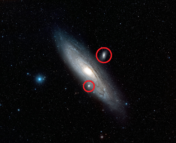The Undergraduate Research series is where we feature the research that you’re doing. If you are an undergraduate that took part in an REU or similar astro research project and would like to share this on Astrobites, please check out our submission page for more details. We would also love to hear about your more general research experience!
Fred Angelo Batan Garcia
University of Maryland, College Park

This guest post was written by Fred Angelo Batan Garcia. Fred is finishing up his bachelor’s degree in physics and astronomy at the University of Maryland, College Park. This work – set to appear in MNRAS Volume 522, Issue 2, June 2023 – was completed under the guidance of Massimo Ricotti, a professor at the Maryland Astronomy Center for Theory and Computation with whom Fred has been working with since his second year. You can view his website here.
Globular clusters (GCs) are among the oldest objects in the Universe; estimates place their birth at z > 6, within the first billion years of cosmic history. However, the origin of these present-day relics (with total masses ranging from a few thousand to a million or so solar masses, and radii as big as ~100 pc) is still a mystery.
Using state-of-the-art radiation-hydrodynamic cosmological simulations, we study their origins and early evolution in high-redshift dwarf galaxies under different star formation efficiencies (SFEs). Poorly constrained at high-redshift, this is a measure of how well a given molecular cloud converts gas to stars. In this parameter study, we find that the total stellar mass produced by the galaxy is insensitive to SFE. This shows self-regulation at the galactic scale, where high SFEs cause more intense – albeit less often due to more prolonged quench times – star formation periods. However, the star cluster population in the two simulations show a significant difference in terms of morphology (see animated Figure 1 below), with the high SFE run producing compact bound star clusters that are analogues to GC progenitors but typically of smaller mass (masses between a few 100 to 2 × 10^4 M☉ and half-mass radii of up to ∼3 pc).
We expect this newly revealed population of GC ancestors to ultimately not survive to z = 0 due to evaporation via two-body relaxation, which is a process important in dense stellar systems whereby two-body encounters between stars are more common. Nonetheless, they offer clues to questions about the drivers of the Epoch of Reionization and offer us insights into the true nature of highly-compact, star-cluster-like objects recently observed by the James Webb Space Telescope.
Astrobite edited by: Ali Crisp




